| Wind Watch is a registered educational charity, founded in 2005. |
Obstacles facing US wind energy
Credit: Gail Tverberg, January 4, 2012, ourfiniteworld.com ~~
Translate: FROM English | TO English
Translate: FROM English | TO English
In the United States, we have been working on scaling up wind energy but not getting very far. In 2010, wind energy supplied only 2.3% of electricity purchased.
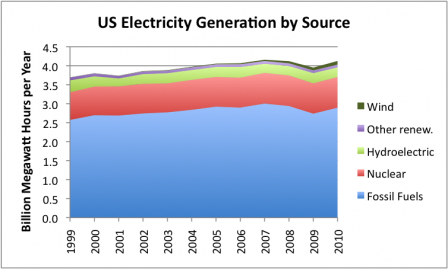
Figure 1. Wind energy (dark green) is barely visible in a graph of US energy consumption by source. Based on EIA data.
Such slow progress seems strange for a product that seems to have such great promise. It can reduce CO2 emissions. It doesn’t require fuel. It is at least partly US made. It seems to have promise for protecting against rising fossil fuel prices.
In this post, I discuss a few of the obstacles facing wind energy in the United States and their implications for the expansion of wind energy.
Obstacle 1: Wind energy is dependent on large subsidies.
According to the EIA’s report, Direct Federal Financial Interventions and Subsidies in Energy in Fiscal Year 2010, wind energy received subsidies of $4.986 billion from the federal government for Fiscal Year 2010. This amount is equal to approximately half the cost of new wind power installed during that period. State and local subsidies would be in addition. (The US Wind Energy Association shows that 6034 megawatts of new capacity was installed between October 1, 2009 and September 30, 2010, so the subsidy per megawatt was $826,318. This compares to an average cost per megawatt of about $1.4 million, excluding construction and connection costs.)
Wind energy’s largest subsidy, the Production Tax Credit, is set to expire on December 31, 2012, unless Congress acts to extend it, so there is now a big rush to get orders filled before that date. A study by Navigant Consulting forecasts a large drop in wind investment, if the Production Tax Credit is not extended (Figure 2).
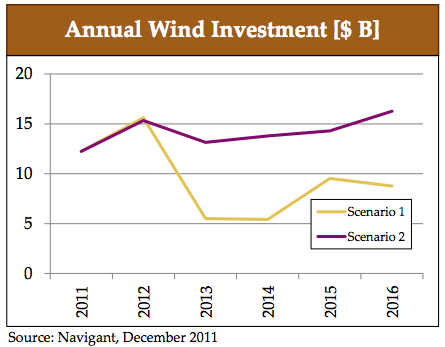
Figure 2. Annual Investment in Wind Energy in $ Billion, according to Navigant Consulting.
Needless to say, the US Federal Government is not flush with money for subsidies, so there is the possibility that subsidies will not be renewed or will be cut back.
Obstacle 2: Wind energy is more variable than electricity produced by fossil fuels and by nuclear energy.
Wind blows when it chooses, which is often not when it is needed most. In theory, this problem could be resolved with robust long-distance transmission of electricity and with adequate electrical storage, but in the US, these are not available. Bill Richardson, energy secretary under Bill Clinton has said, “We’re a superpower with a Third World grid.” This means that even in locations where wind energy makes up a relatively large share of the fuel mix, other types of generations must be available to supply almost the full level of demand, if the wind is not blowing.
As a result, the role of wind energy is fairly limited. What wind energy does is permit electricity generating plants, particularly those fueled by natural gas, to use less fuel. Consequently, the price of wind energy tends to compete with the price of fuel, rather than with the wholesale price of electricity.
Chis Namoviz, who is in charge of renewable energy forecasting at the EIA, explained this to me in an e-mail in 2009:
Because of its relatively low “capacity value” (a result of usually not blowing very regularly during peak load hours), wind largely competes as a “fuel saver” resource, and can generally be compared against the fuel cost of what ever mix of fuel it is displacing (whether from existing capacity or from alternative investments in future capacity). In the U.S., this is typically some mix of relatively inexpensive coal and somewhat expensive natural gas, depending on the location of the wind plant, and the resulting seasonal/daily wind and load profiles . . .[Note from Gail: Natural gas is now cheaper than when this statement was made.]
We can see the result of this situation in Figure 3, from Annual Report on U. S. Wind Power Installation, Cost, and Performance Trends: 2007. The price of wind generation tends to trade a below the wholesale band for other types of wind generation, more at the price of the fuel that is saved (frequently natural gas) than at the usual wholesale price.
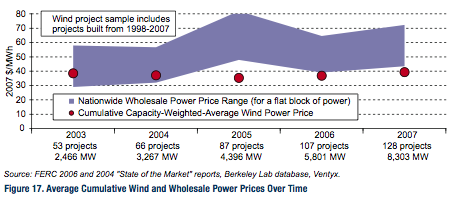
Figure 3. Comparison of prices of wind generated electricity with electricity generated by other means, from US Department of Energy report, "Annual Report on U. S. Wind Power Installation, Cost, and Performance Trends: 2007."
This lower price for wind-generated electricity helps explain some of the need for subsidies.
A related issue is the confusion caused by a comparison of the “levelized cost of wind” with the levelized cost of other types of generation, such as is shown in Figure 4 by the US Energy Information Administration.
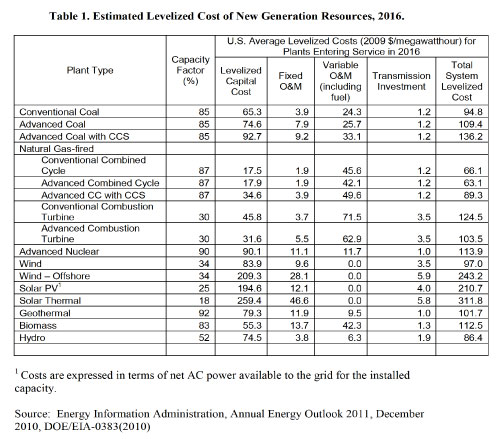
Figure 4. EIA's exhibit showing Estimated Levelized Cost of New Electricity Generation Resources, from Annual Energy Outlook 2011.
Because wind acts as a fuel-saver, Figure 4 represents an “apples to oranges” comparison, if one makes the standard comparison of amounts in the last column. Instead, since wind energy only replaces fuel, what needs to be compared is
- “Total System Levelized Cost” for wind relative to
- “Variable O&M (including fuel)” for other sources of production
In Figure 4, the Total System Levelized Cost of Wind is 97.0, and of Wind-Offshore is 243.2. These might be compared with the Variable O&M (including fuel) of coal (Advanced coal is 25.7) or of natural gas (Conventional Combined Cycle is 45.6), for example. On this basis, wind energy comes out badly, and is one reason it requires such high subsides.
Another related issue is that a person would normally want to substitute a less-scarce fuel for a more scarce fuel, but to some extent this works in reverse for wind power. At least some petroleum is used in manufacturing, transporting, installing, and maintaining wind turbines, but the energy that is provided as an output is mostly replacing natural gas, and perhaps some coal. Coal and natural gas are much cheaper (and more abundant) than oil, so even a small input/output substitution in this direction can quickly hurt the economics of the process.
While one intent of wind energy was to protect against rising fossil fuel prices, in the US those prices are not rising evenly. Oil is particularly high priced, but it is not oil that is being saved, it is other fuels.
Obstacle 3: Natural gas is now very cheap in the US, and there is a huge amount of natural gas generating capacity already built.
Since wind energy tends to compete with the cost of fossil fuels used to produce electricity (mostly natural gas and coal in the US), a low price for natural gas is a problem because even greater subsidies will be required for wind energy to be competitive.
Furthermore, natural gas generating capacity is no issue, because a great deal of natural gas generating capacity has been added in recent years.
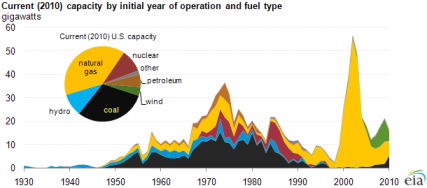
Figure 5: US Generation Capacity by Year and Source, based on EIA Data. (The amount of electricity generated is not proportional to capacity, however. Nuclear is used at over 90% of capacity, coal a little below 70%, and wind at a little under 30% of capacity.)
Obstacle 4: In the US, we do not have an electrical grid that can provide very much long distance transport of electricity, and there are several reasons why changing this situation is very difficult.
Growth in wind energy requires very good long distance transmission capability, partly because wind resources are often located a long way from prospective users, and partly because the variable nature of wind can be “evened out” if wind energy is shared over a large area. Unfortunately, the US electrical system has grown up under a system where each locality has been expected to generate its own electricity. Under such a system, electrical transmission from city to city was originally designed to handle only occasional emergencies, and thus is very limited. I have written more about US electrical grid issues in The US Electrical Grid: Will it Be Our Undoing? and Upgrading the Grid – Many Pluses but Some Minuses Too.
The way the US electric transmission system was set up produces many anomalies. Electrical rates vary greatly from state to state. We needlessly burn large amounts of oil transporting coal to where it will be burned for electricity, rather than burning it near where the coal is mined, and then transporting the electric power over transmission lines. Nuclear-fueled power plants are sometimes located near large cities.
The problem is very difficult to fix for many reasons. Any improvement in electric transmission would tend to even out electricity rates, but this would be to the detriment of customers who currently have low electric rates. To the extent that new transmission costs more, and these higher costs are charged back in electric rates, such a change could result in higher electricity costs for more than half of the population–something most politicians would find unacceptable.
If better transmission were readily available and free, no one would want to build a power plant in their back yard, making it even harder to site new power plants than it is now.
Another issue is that a good mechanism for paying for the installation and maintenance of new long distance transmission lines has not been established. Under current procedures, a determination must be made as to which electric generating companies will benefit from new transmission lines, and the costs allocated among the beneficiaries. The government in the past has not funded long distance electrical transmission. No one really “owns” the long distance lines.
The only partial fix I can see would be to create a separate organization to build and maintain a few new long-distance transmission lines. Wind energy and other users seeking to use these lines would be charged for the use of these lines, similar to a toll road. It might be possible that more coal fired-power plants would be built near these lines, because wind usage by itself could not support these lines. Even this arrangement would likely require a change to current laws. The net effect might be more CO2, rather than less.
The cost of long distance electric transmission is likely to be fairly high–at least several cents per kWh, for wind energy transported over long distances. Over time, the price can be expected to rise as the price of oil rises. Some maintenance may become very difficult, such as that currently done by helicopters in remote locations.
Obstacle 5: A high proportion of funding for wind energy is up front.
Oil, coal, and gas all started out as fairly high EROEI investments, and much of the investment took place as the fuel was extracted. In such a situation, the investments threw off a high level of profit which could be used to fund further investment.
Fossil fuels are gradually shifting away from this model, with higher up front investment, and lower profit available to fund further investment. Wind turbines represent the extreme end of this continuum with most of the investment up front, and the return trailing many years behind.
As a result of this shift in timing, it is becoming more difficult to fund projects with huge up-front investment. In the “good old days,” we had the low price of fossil fuels which made other investments easier to afford. We also could count on a being always able to add more debt, but we are reaching limits on sustainable debt. I wrote two posts on The Link Between Peak Oil and Peak Debt (Part 1 and Part 2). More recently, I talked about how Net Savings is dropping dramatically in the US, so that non-debt sources of funding are also disappearing.

Figure 6. US Savings and Investment Ratios, based on US Bureau of Economic Analysis Data.
The net of all of this is that if we are reaching limits with respect to finite resources, it is going to be increasingly difficult to fund projects that require large up-front investment and provide a return later. We will likely have to give up some investments we really need (such as replacing worn out roads, pipelines, and school buildings) in order to ramp up investments in projects that require large front-end funding, like wind turbines.
Obstacle 6: Adding wind energy to the electric grid adds complexity which may be difficult to manage with declining resources.
The job of balancing supply with electrical demand and keeping all sources of electricity “in synch” becomes more difficult, as more variable sources of supply come on line. While it is theoretically possible to find technical solutions to these issues, it is not clear that we will in practice.
Furthermore, one approach that is being tried in order to avoid the cost of adding new electricity generating capacity and new electric transmission is to use the Smart Grid to help limit demand when at times when demand would normally be high, such as when temperatures are high or low. In the words of Smart Grid R & D: 2010-2014 Draft 2, “Smart grid can improve asset utilization and thereby avoid the need for new capacity.“
The expected effect of avoiding new capacity is that components are operated at closer to maximum capacity. Since adding new capacity is avoided, assets will over time tend to be older as well. While theoretically everything should go well, operating older units at closer to their theoretical capacity adds stresses to the system. Because of these factors, Smart Grid enhancements add efficiency to the system, but may reduce resilience.
According to the same report, the Smart Grid is being built as it is being planned. The amount of funding is not clear; costs must be recovered from customers based on cost recovery laws which vary by state. There are a huge number of details that need to worked out, such as necessary cyber security measures. It would be easier to rest easy if the Smart Grid had all been planned out in advance, tested on a small scale and pre-funded.
The grid with the new enhancements will work until at some point it doesn’t work–for example, an unplanned event causes a major failure within the system, or a needed system upgrade is too expensive to afford, or a replacement part from overseas is unavailable. Hopefully, failures of this type will be temporary and local, but if resources are limited, the time may come when the high cost of maintaining the system becomes unsustainable.
Further Thoughts about Wind Energy
I have not been able to touch on more than a few issues in this post.
One of the big issues with wind is that hopes have been raised for its widespread use, without really working through feasibility issues. If we are already having trouble with the electrical grid not being able to accept more wind energy in popular wind-generating areas when wind energy constitutes only 2.3% of total electricity supply, then wind energy is going to be difficult to scale up quickly. The issues I point out in this article suggest that the cost problem is still large, and the fixes needed to add long-distance transmission are likely to make the cost problem even worse.
The government needs to be able to show it is “doing something” about our energy problem, so it makes statements such as “Wind generation added 30% of all US generating capacity in 2007.” (See Figure 5 above.) Few people are energy literate enough to realize that even this progress is very slow, because relatively little new capacity is added in a year, and because wind, with its low-capacity factor, requires a disproportionate share of total new generation capacity, to make much progress. If wind turbines have an average life of 20-30 years, and other types of generation last for 40+ years, this will also affect the amount of new generation needed for wind, compared to other units.
It is easy for readers to become confused, when confronted with the many technology possibilities available, when they don’t understand the time, cost, and scale involved. Dr. Robert Hirsch, in the January 9, 2012, issue of the ASPO-USA Peak Oil Review writes:
The foregoing are realities that many people fail to understand, which means that they can be trapped into advocating energy changes that are not practical in the short term. Examples of some of the current common traps: 1) Assuming that wind and solar systems – electricity producers – can be a near-term solution to high gasoline prices; 2) Assuming that natural gas from shale is a near-term solution to our dependence on foreign oil; 3) Assuming that wind and solar can be a near-term means to lower the emissions from vehicles now powered by oil products; etc.
If transitions to new energy sources and new technologies could be made cheaply and quickly, then many options that appear to be feasible in fact would have a reasonable chance of working out. But there is another issue as well. Based on technology today, we need fossil fuels to make wind energy, and we need fossil fuels to transport wind turbines to the locations where they are to be installed. We also need fossil fuels to repair wind turbines and to maintain transmission lines. So wind energy and other proposed replacements for fossil fuels are deeply imbedded in the fossil fuel system, and dependent on it.
I expect that at some point grid problems will become overwhelming, so at least the long-distance portion of the grid will be lost. It is possible that adding more wind energy to the grid will make that date come sooner, rather than later, because of the complexity issues I mentioned. Unless the limiting factor on the life of the electric grid is the amount of coal and natural gas available, and wind energy somehow delays running out of these, I have a hard time seeing how wind energy will make the electric grid last longer.
There are so many obstacles for wind to overcome in the US that I am not sure that we should even try to push for higher wind penetration levels. The only exception might be in areas where wind energy is cheap to produce and the grid can readily accept the electricity.
Since the world is finite, there is a good chance that at some point we are going to have to get along with less electricity as well as less oil. Instead of focusing on delaying the inevitable, perhaps we should start thinking about preparing people for simpler lives that use less energy of all types. Such an approach might solve multiple problems at once – too much CO2, too little oil, and too little capital to tackle all the problems that need to be tackled at once.
This article is the work of the source indicated. Any opinions expressed in it are not necessarily those of National Wind Watch.
The copyright of this article resides with the author or publisher indicated. As part of its noncommercial educational effort to present the environmental, social, scientific, and economic issues of large-scale wind power development to a global audience seeking such information, National Wind Watch endeavors to observe “fair use” as provided for in section 107 of U.S. Copyright Law and similar “fair dealing” provisions of the copyright laws of other nations. Send requests to excerpt, general inquiries, and comments via e-mail.
| Wind Watch relies entirely on User Funding |
 (via Stripe) |
 (via Paypal) |
Share:

